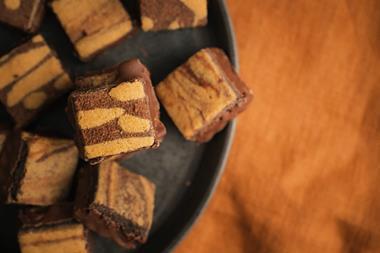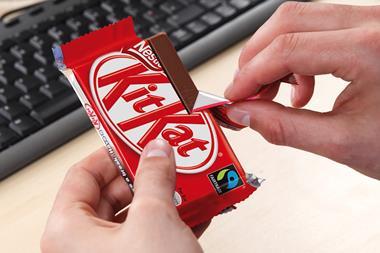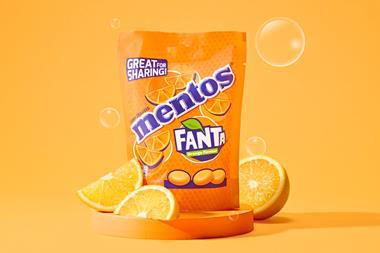Sales of sharing bags and boxed chocolate have soared as Brits spend their evenings at home. But impulse goods have suffered as a result, reports Simon Creasey
Chocolate is seen as recession-proof one of the few categories that can weather even the harshest financial storm and, true to form, it appears to have been relatively unscathed by the economic turmoil.
Sales of chocolate confectionery have grown 7.4% to £2.2bn over the past year and volumes are up 4.9% outperforming sugar confectionery significantly [Kantar Worldpanel 52w/e 11 July 2010]. Much of this growth can be attributed to the strong performance of bitesize and sharing formats. Lighter options have also done well, as, somewhat more surprisingly, has premium chocolate.
But what's behind their success? Will they be able to keep it up? And what can be done to revive impulse sales, which were in trouble before the revelation this week that both Cadbury and Nestlé are about to increase the rsp of their countlines in response to rising commodity prices?
While impulse sales are still struggling after the last round of price rises and product size reductions, sharing bag sales have gone from strength to strength. "The trend for the 'big night in' has driven category growth, with consumers turning to entertaining at home to save money," says Mars trade relations manager Bep Sandhu.
This in turn has presented manufacturers with the opportunity to turn up the NPD gas with a raft of new bitesize and sharing formats that not only give consumers what they want but also maximise the sales per square foot for retailers in a way countlines never could.
The past year has seen unprecedented levels of NPD. We've had the likes of Werther's launching its first foray into chocolate this January with the Original Chocolate range (£1.99 for a 125g bag) and recently extending the line-up with Caramelts to attract younger consumers. We've also seen a host of new launches featuring bitesize portions of lighter brands tapping into two trends in one fell swoop.
Nestlé launched its Aero Bubbles Peppermint box (rsp: £3.99) last month, to compete with boxes of Maltesers, and Cadbury has brought out its bitesize Crunchie Rocks and Dairy Milk Caramel Nibbles, while Mars has launched Milky Way Magic Stars and Galaxy Counters.
Not only do such launches satisfy consumer demand for affordable treats and for the ladies offer the suggestion, if not the reality, of portion control, they are also perceived to offer value for money.
As with sugar confectionery, sharing bags at round-pound price points are proving a hit (see page 66). "Shoppers see this format as potentially better value than a countline bar, which can retail in excess of 55p," says Hancocks Cash & Carry purchasing director Jonathan Summerley.
With mounting interest in sharing bags, it is perhaps no surprise that there has been a decline in impulse sales, says Malachy McReynolds, MD at Elizabeth Shaw. "A third of consumers claim they eat less chocolate than a year ago, most likely prompted by healthy-eating concerns," she says. "The impulse sector is likely to suffer the most, with purchases of chocolate being replaced by something with much healthier credentials."
Or simply lower-calorie chocolate. "The usage occasion of buying the heavier brands a Mars bar or a Snickers as a chocolate fix is starting to decline," notes Ferrero UK head of customer development Levi Boorer. "What you're seeing is a growth in lighter indulgence."
Hence NPD such as Galaxy Bubbles and Twix Fino from Mars. The company has also reformulated old favourites such as Mars and Snickers, reducing their saturated fat content by 15% with, it claims, no discernible difference in taste. Meanwhile, Cadbury has launched Wispa Duo, which the company describes as a "portionable treat for those who prefer to share their bar or save some for later" and, last month, Nestlé launched a 165-calorie Kit Kat Senses Caramel Cream bar. Lighter isn't the only avenue being explored as manufacturers try to reinvent the countline and revive impulse sales.
Cadbury is hoping to inject more excitement into the countline sector with its Spots v Stripes Challenge Bar, which has been launched to tie in with the Olympic Games. Part confectionery product/part game, the bar is split into three sections and consumers are encouraged to play a game to see who wins the third chunk. Games suggestions printed on the inside of the wrapper include waste paper basketball. Cadbury is spending £14m on promoting the Spots v Stripes bar in 2010 alone.
On a more modest scale, Elizabeth Shaw is making its Mint Crisp chocolates available in 99p seven-piece impulse packs.
But although countlines are being forced to raise their games to keep up with sharing and lighter formats and justify their price tags, price isn't the be all and end all.
Paradoxically, premium chocolate is thriving despite its price premium. Sales of Green & Black's have leapt 32%, according to UK customer marketing manager Tracy Russell, who attributes the results to increased distribution and promotional activity. "Stocking Green & Black's appeals to 'golden basket' shoppers who buy premium products, and encourages mainstream consumers to trade up into premium chocolate," she says.
And consumers aren't just buying chocolate as an affordable treat for themselves. Gifting is also contributing to overall category growth, despite the disappearance of one of its most influential retailers.
"The demise of Woolworths had a big impact, and a lot of manufacturers were wondering where they were going to maintain the volume and value Woolworths provided as a retailer," says Ferrero's Boorer. But high-street sales have remained relatively buoyant, as the likes of Debenhams and WHSmith have built up their chocolate gifting businesses.
When it comes to individual brand performance, the strongest showing was from comeback kid Cadbury Wispa (it's no concidence that it's a lighter bar), with value sales up 44.6% as unit sales rose 25.7%."Wispa continues to perform phenomenally well," says Margaret Jobling, marketing director for everyday chocolate at Cadbury. Since its relaunch in 2008, annual sales have reached almost £54m [SymphonyIRI] not bad for a brand that was dumped in 2003 due to poor sales.
While Wispa has had lots to shout about, value sales of stablemate Dairy Milk fell 1.7% as volume dropped 10.7%. Things were no better for Aero, with value falling by 4.9% and volume by 9.4% [SymphonyIRI].
Mars' products also experienced mixed fortunes. Although value sales of Galaxy and M&M's have risen by 19.1% and 14.4% respectively, sales of Snickers have slumped 2.7% by value and 7.4% by volume. Mars bars fared better, with value sales up 2.8% and volume down 1.2%, while value sales of Maltesers rose 5.1% [SymphonyIRI 52w/e 17 July]. Nestlé's Kit Kat, meanwhile, enjoyed value sales growth of 1.4% although unit sales dipped 2.8% [SymphonyIRI].
Despite the ups and downs, the chocolate category has had a good year. The level of NPD has played a critical role but that's not the only factor, says Nestlé UK trade communications manager Graham Walker. The challenge, he says, is to "invest across the marketing mix above the line, in promotions, and in NPD and innovation".
For those that do this, the future is looking healthy even if some of their core products aren't.
Buyer interview: Ben Wheeley, confectionery buyer at Sainsbury's
How has the recession impacted chocolate?
Customers are shopping for value; there has been strong growth in Sainsbury's Basics and a significant increase in the percentage of products sold on promotions. We have focused our promotions on the family shopper, with increasing numbers of 'save' promotions on store cupboard lines, such as larger chocolate bars and multipacks.
What moves are being made to make the sector more sustainable?
Manufacturers are working to support the long-term viability of cocoa supply and are investing in ethical schemes such as Fairtrade and Rainforest Alliance. I expect this to continue as manufacturers invest to secure their future supply.
What has been the most successful product launch in the past 12 months?
NPD this year has been more evolutionary than revolutionary. The stars have been impulse chocolate linked to events the MaltEaster bunny and Cadbury's Caramel Bunny have created a whole new market.
What will be the key trends in the coming 12 months?
Customer confidence is slowly returning and I am expecting branded innovation to become more adventurous. We are excited about relaunching our Taste the Difference range, which will emphasise origins chocolate (Ghana, Ecuador, Peru and Santo Domingo).
Focus On Confectionery
Chocolate is seen as recession-proof one of the few categories that can weather even the harshest financial storm and, true to form, it appears to have been relatively unscathed by the economic turmoil.
Sales of chocolate confectionery have grown 7.4% to £2.2bn over the past year and volumes are up 4.9% outperforming sugar confectionery significantly [Kantar Worldpanel 52w/e 11 July 2010]. Much of this growth can be attributed to the strong performance of bitesize and sharing formats. Lighter options have also done well, as, somewhat more surprisingly, has premium chocolate.
But what's behind their success? Will they be able to keep it up? And what can be done to revive impulse sales, which were in trouble before the revelation this week that both Cadbury and Nestlé are about to increase the rsp of their countlines in response to rising commodity prices?
While impulse sales are still struggling after the last round of price rises and product size reductions, sharing bag sales have gone from strength to strength. "The trend for the 'big night in' has driven category growth, with consumers turning to entertaining at home to save money," says Mars trade relations manager Bep Sandhu.
This in turn has presented manufacturers with the opportunity to turn up the NPD gas with a raft of new bitesize and sharing formats that not only give consumers what they want but also maximise the sales per square foot for retailers in a way countlines never could.
The past year has seen unprecedented levels of NPD. We've had the likes of Werther's launching its first foray into chocolate this January with the Original Chocolate range (£1.99 for a 125g bag) and recently extending the line-up with Caramelts to attract younger consumers. We've also seen a host of new launches featuring bitesize portions of lighter brands tapping into two trends in one fell swoop.
Nestlé launched its Aero Bubbles Peppermint box (rsp: £3.99) last month, to compete with boxes of Maltesers, and Cadbury has brought out its bitesize Crunchie Rocks and Dairy Milk Caramel Nibbles, while Mars has launched Milky Way Magic Stars and Galaxy Counters.
Not only do such launches satisfy consumer demand for affordable treats and for the ladies offer the suggestion, if not the reality, of portion control, they are also perceived to offer value for money.
As with sugar confectionery, sharing bags at round-pound price points are proving a hit (see page 66). "Shoppers see this format as potentially better value than a countline bar, which can retail in excess of 55p," says Hancocks Cash & Carry purchasing director Jonathan Summerley.
With mounting interest in sharing bags, it is perhaps no surprise that there has been a decline in impulse sales, says Malachy McReynolds, MD at Elizabeth Shaw. "A third of consumers claim they eat less chocolate than a year ago, most likely prompted by healthy-eating concerns," she says. "The impulse sector is likely to suffer the most, with purchases of chocolate being replaced by something with much healthier credentials."
Or simply lower-calorie chocolate. "The usage occasion of buying the heavier brands a Mars bar or a Snickers as a chocolate fix is starting to decline," notes Ferrero UK head of customer development Levi Boorer. "What you're seeing is a growth in lighter indulgence."
Hence NPD such as Galaxy Bubbles and Twix Fino from Mars. The company has also reformulated old favourites such as Mars and Snickers, reducing their saturated fat content by 15% with, it claims, no discernible difference in taste. Meanwhile, Cadbury has launched Wispa Duo, which the company describes as a "portionable treat for those who prefer to share their bar or save some for later" and, last month, Nestlé launched a 165-calorie Kit Kat Senses Caramel Cream bar. Lighter isn't the only avenue being explored as manufacturers try to reinvent the countline and revive impulse sales.
Cadbury is hoping to inject more excitement into the countline sector with its Spots v Stripes Challenge Bar, which has been launched to tie in with the Olympic Games. Part confectionery product/part game, the bar is split into three sections and consumers are encouraged to play a game to see who wins the third chunk. Games suggestions printed on the inside of the wrapper include waste paper basketball. Cadbury is spending £14m on promoting the Spots v Stripes bar in 2010 alone.
On a more modest scale, Elizabeth Shaw is making its Mint Crisp chocolates available in 99p seven-piece impulse packs.
But although countlines are being forced to raise their games to keep up with sharing and lighter formats and justify their price tags, price isn't the be all and end all.
Paradoxically, premium chocolate is thriving despite its price premium. Sales of Green & Black's have leapt 32%, according to UK customer marketing manager Tracy Russell, who attributes the results to increased distribution and promotional activity. "Stocking Green & Black's appeals to 'golden basket' shoppers who buy premium products, and encourages mainstream consumers to trade up into premium chocolate," she says.
And consumers aren't just buying chocolate as an affordable treat for themselves. Gifting is also contributing to overall category growth, despite the disappearance of one of its most influential retailers.
"The demise of Woolworths had a big impact, and a lot of manufacturers were wondering where they were going to maintain the volume and value Woolworths provided as a retailer," says Ferrero's Boorer. But high-street sales have remained relatively buoyant, as the likes of Debenhams and WHSmith have built up their chocolate gifting businesses.
When it comes to individual brand performance, the strongest showing was from comeback kid Cadbury Wispa (it's no concidence that it's a lighter bar), with value sales up 44.6% as unit sales rose 25.7%."Wispa continues to perform phenomenally well," says Margaret Jobling, marketing director for everyday chocolate at Cadbury. Since its relaunch in 2008, annual sales have reached almost £54m [SymphonyIRI] not bad for a brand that was dumped in 2003 due to poor sales.
While Wispa has had lots to shout about, value sales of stablemate Dairy Milk fell 1.7% as volume dropped 10.7%. Things were no better for Aero, with value falling by 4.9% and volume by 9.4% [SymphonyIRI].
Mars' products also experienced mixed fortunes. Although value sales of Galaxy and M&M's have risen by 19.1% and 14.4% respectively, sales of Snickers have slumped 2.7% by value and 7.4% by volume. Mars bars fared better, with value sales up 2.8% and volume down 1.2%, while value sales of Maltesers rose 5.1% [SymphonyIRI 52w/e 17 July]. Nestlé's Kit Kat, meanwhile, enjoyed value sales growth of 1.4% although unit sales dipped 2.8% [SymphonyIRI].
Despite the ups and downs, the chocolate category has had a good year. The level of NPD has played a critical role but that's not the only factor, says Nestlé UK trade communications manager Graham Walker. The challenge, he says, is to "invest across the marketing mix above the line, in promotions, and in NPD and innovation".
For those that do this, the future is looking healthy even if some of their core products aren't.
Buyer interview: Ben Wheeley, confectionery buyer at Sainsbury's
How has the recession impacted chocolate?
Customers are shopping for value; there has been strong growth in Sainsbury's Basics and a significant increase in the percentage of products sold on promotions. We have focused our promotions on the family shopper, with increasing numbers of 'save' promotions on store cupboard lines, such as larger chocolate bars and multipacks.
What moves are being made to make the sector more sustainable?
Manufacturers are working to support the long-term viability of cocoa supply and are investing in ethical schemes such as Fairtrade and Rainforest Alliance. I expect this to continue as manufacturers invest to secure their future supply.
What has been the most successful product launch in the past 12 months?
NPD this year has been more evolutionary than revolutionary. The stars have been impulse chocolate linked to events the MaltEaster bunny and Cadbury's Caramel Bunny have created a whole new market.
What will be the key trends in the coming 12 months?
Customer confidence is slowly returning and I am expecting branded innovation to become more adventurous. We are excited about relaunching our Taste the Difference range, which will emphasise origins chocolate (Ghana, Ecuador, Peru and Santo Domingo).
Focus On Confectionery








No comments yet